Financial Analysis and Investment Appraisal Report - [University Name]
VerifiedAdded on 2023/01/10
|15
|3945
|21
Report
AI Summary
This report provides a detailed analysis of financial analysis and investment appraisal techniques. It begins with an introduction to financial analysis, emphasizing its importance in evaluating an organization's performance, sustainability, and financial viability. The main body of the report focuses on a critical evaluation of investment appraisal methods, including Net Present Value (NPV), Payback Period, and Internal Rate of Return (IRR), detailing their advantages and disadvantages. The report includes a comparative analysis of three development projects based on these methods, offering insights into their profitability and payback periods. Furthermore, the report addresses the scenario of a family-owned supermarket business seeking a loan of 30 million. It explores various sources of long-term finance, such as equity shares and term loans, outlining their benefits and drawbacks. The report concludes by summarizing the key findings and implications of the financial analysis and investment appraisal techniques discussed.

Financial Analysis
Management & Enterprise
Management & Enterprise
Paraphrase This Document
Need a fresh take? Get an instant paraphrase of this document with our AI Paraphraser

Contents
INTRODUCTION...........................................................................................................................3
MAIN BODY...................................................................................................................................3
Task 1.....................................................................................................................................3
..........................................................................................................................................................7
Task 2.....................................................................................................................................9
CONCLUSION..............................................................................................................................13
REFERENCES..............................................................................................................................14
INTRODUCTION...........................................................................................................................3
MAIN BODY...................................................................................................................................3
Task 1.....................................................................................................................................3
..........................................................................................................................................................7
Task 2.....................................................................................................................................9
CONCLUSION..............................................................................................................................13
REFERENCES..............................................................................................................................14
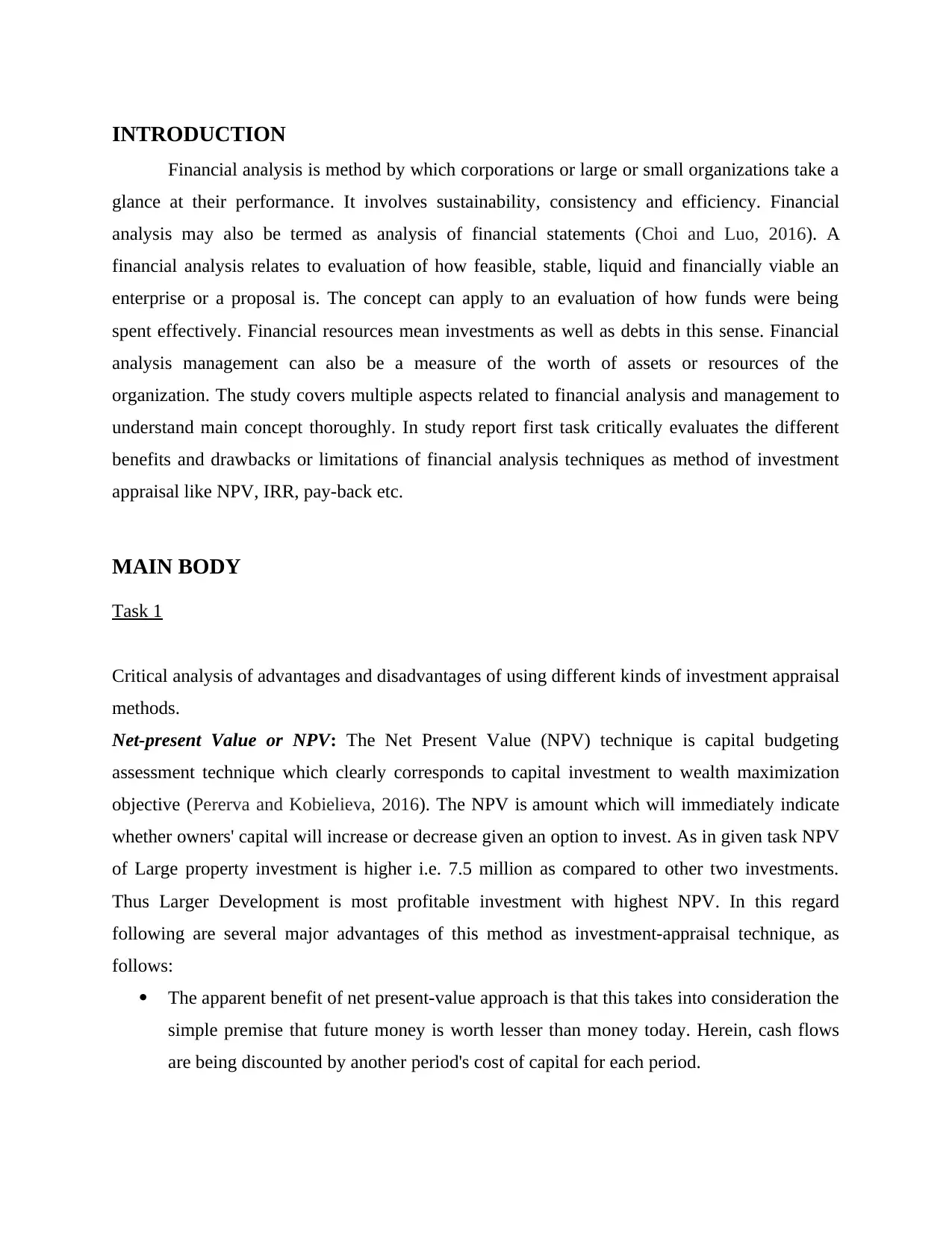
INTRODUCTION
Financial analysis is method by which corporations or large or small organizations take a
glance at their performance. It involves sustainability, consistency and efficiency. Financial
analysis may also be termed as analysis of financial statements (Choi and Luo, 2016). A
financial analysis relates to evaluation of how feasible, stable, liquid and financially viable an
enterprise or a proposal is. The concept can apply to an evaluation of how funds were being
spent effectively. Financial resources mean investments as well as debts in this sense. Financial
analysis management can also be a measure of the worth of assets or resources of the
organization. The study covers multiple aspects related to financial analysis and management to
understand main concept thoroughly. In study report first task critically evaluates the different
benefits and drawbacks or limitations of financial analysis techniques as method of investment
appraisal like NPV, IRR, pay-back etc.
MAIN BODY
Task 1
Critical analysis of advantages and disadvantages of using different kinds of investment appraisal
methods.
Net-present Value or NPV: The Net Present Value (NPV) technique is capital budgeting
assessment technique which clearly corresponds to capital investment to wealth maximization
objective (Pererva and Kobielieva, 2016). The NPV is amount which will immediately indicate
whether owners' capital will increase or decrease given an option to invest. As in given task NPV
of Large property investment is higher i.e. 7.5 million as compared to other two investments.
Thus Larger Development is most profitable investment with highest NPV. In this regard
following are several major advantages of this method as investment-appraisal technique, as
follows:
The apparent benefit of net present-value approach is that this takes into consideration the
simple premise that future money is worth lesser than money today. Herein, cash flows
are being discounted by another period's cost of capital for each period.
Financial analysis is method by which corporations or large or small organizations take a
glance at their performance. It involves sustainability, consistency and efficiency. Financial
analysis may also be termed as analysis of financial statements (Choi and Luo, 2016). A
financial analysis relates to evaluation of how feasible, stable, liquid and financially viable an
enterprise or a proposal is. The concept can apply to an evaluation of how funds were being
spent effectively. Financial resources mean investments as well as debts in this sense. Financial
analysis management can also be a measure of the worth of assets or resources of the
organization. The study covers multiple aspects related to financial analysis and management to
understand main concept thoroughly. In study report first task critically evaluates the different
benefits and drawbacks or limitations of financial analysis techniques as method of investment
appraisal like NPV, IRR, pay-back etc.
MAIN BODY
Task 1
Critical analysis of advantages and disadvantages of using different kinds of investment appraisal
methods.
Net-present Value or NPV: The Net Present Value (NPV) technique is capital budgeting
assessment technique which clearly corresponds to capital investment to wealth maximization
objective (Pererva and Kobielieva, 2016). The NPV is amount which will immediately indicate
whether owners' capital will increase or decrease given an option to invest. As in given task NPV
of Large property investment is higher i.e. 7.5 million as compared to other two investments.
Thus Larger Development is most profitable investment with highest NPV. In this regard
following are several major advantages of this method as investment-appraisal technique, as
follows:
The apparent benefit of net present-value approach is that this takes into consideration the
simple premise that future money is worth lesser than money today. Herein, cash flows
are being discounted by another period's cost of capital for each period.
⊘ This is a preview!⊘
Do you want full access?
Subscribe today to unlock all pages.

Trusted by 1+ million students worldwide
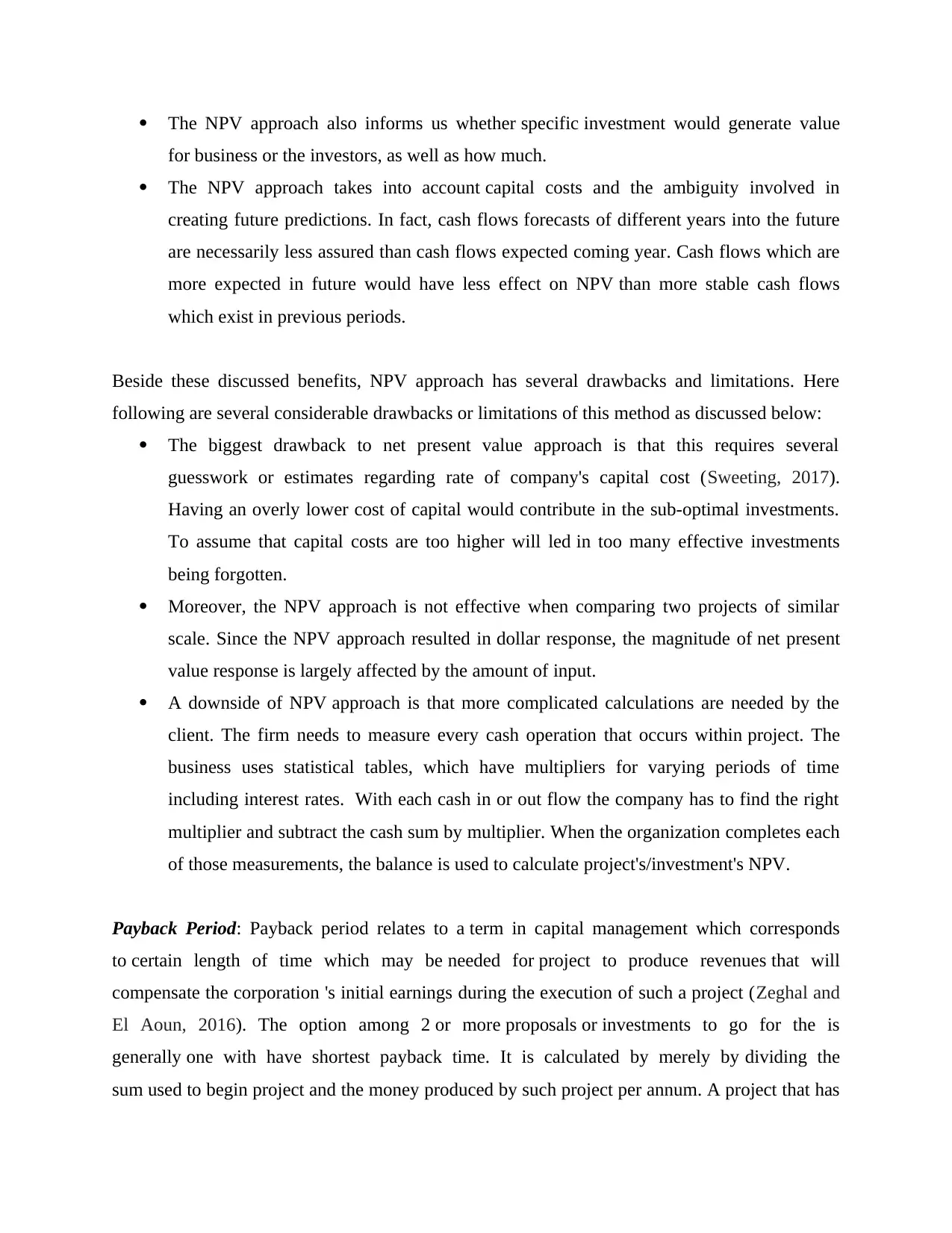
The NPV approach also informs us whether specific investment would generate value
for business or the investors, as well as how much.
The NPV approach takes into account capital costs and the ambiguity involved in
creating future predictions. In fact, cash flows forecasts of different years into the future
are necessarily less assured than cash flows expected coming year. Cash flows which are
more expected in future would have less effect on NPV than more stable cash flows
which exist in previous periods.
Beside these discussed benefits, NPV approach has several drawbacks and limitations. Here
following are several considerable drawbacks or limitations of this method as discussed below:
The biggest drawback to net present value approach is that this requires several
guesswork or estimates regarding rate of company's capital cost (Sweeting, 2017).
Having an overly lower cost of capital would contribute in the sub-optimal investments.
To assume that capital costs are too higher will led in too many effective investments
being forgotten.
Moreover, the NPV approach is not effective when comparing two projects of similar
scale. Since the NPV approach resulted in dollar response, the magnitude of net present
value response is largely affected by the amount of input.
A downside of NPV approach is that more complicated calculations are needed by the
client. The firm needs to measure every cash operation that occurs within project. The
business uses statistical tables, which have multipliers for varying periods of time
including interest rates. With each cash in or out flow the company has to find the right
multiplier and subtract the cash sum by multiplier. When the organization completes each
of those measurements, the balance is used to calculate project's/investment's NPV.
Payback Period: Payback period relates to a term in capital management which corresponds
to certain length of time which may be needed for project to produce revenues that will
compensate the corporation 's initial earnings during the execution of such a project (Zeghal and
El Aoun, 2016). The option among 2 or more proposals or investments to go for the is
generally one with have shortest payback time. It is calculated by merely by dividing the
sum used to begin project and the money produced by such project per annum. A project that has
for business or the investors, as well as how much.
The NPV approach takes into account capital costs and the ambiguity involved in
creating future predictions. In fact, cash flows forecasts of different years into the future
are necessarily less assured than cash flows expected coming year. Cash flows which are
more expected in future would have less effect on NPV than more stable cash flows
which exist in previous periods.
Beside these discussed benefits, NPV approach has several drawbacks and limitations. Here
following are several considerable drawbacks or limitations of this method as discussed below:
The biggest drawback to net present value approach is that this requires several
guesswork or estimates regarding rate of company's capital cost (Sweeting, 2017).
Having an overly lower cost of capital would contribute in the sub-optimal investments.
To assume that capital costs are too higher will led in too many effective investments
being forgotten.
Moreover, the NPV approach is not effective when comparing two projects of similar
scale. Since the NPV approach resulted in dollar response, the magnitude of net present
value response is largely affected by the amount of input.
A downside of NPV approach is that more complicated calculations are needed by the
client. The firm needs to measure every cash operation that occurs within project. The
business uses statistical tables, which have multipliers for varying periods of time
including interest rates. With each cash in or out flow the company has to find the right
multiplier and subtract the cash sum by multiplier. When the organization completes each
of those measurements, the balance is used to calculate project's/investment's NPV.
Payback Period: Payback period relates to a term in capital management which corresponds
to certain length of time which may be needed for project to produce revenues that will
compensate the corporation 's initial earnings during the execution of such a project (Zeghal and
El Aoun, 2016). The option among 2 or more proposals or investments to go for the is
generally one with have shortest payback time. It is calculated by merely by dividing the
sum used to begin project and the money produced by such project per annum. A project that has
Paraphrase This Document
Need a fresh take? Get an instant paraphrase of this document with our AI Paraphraser
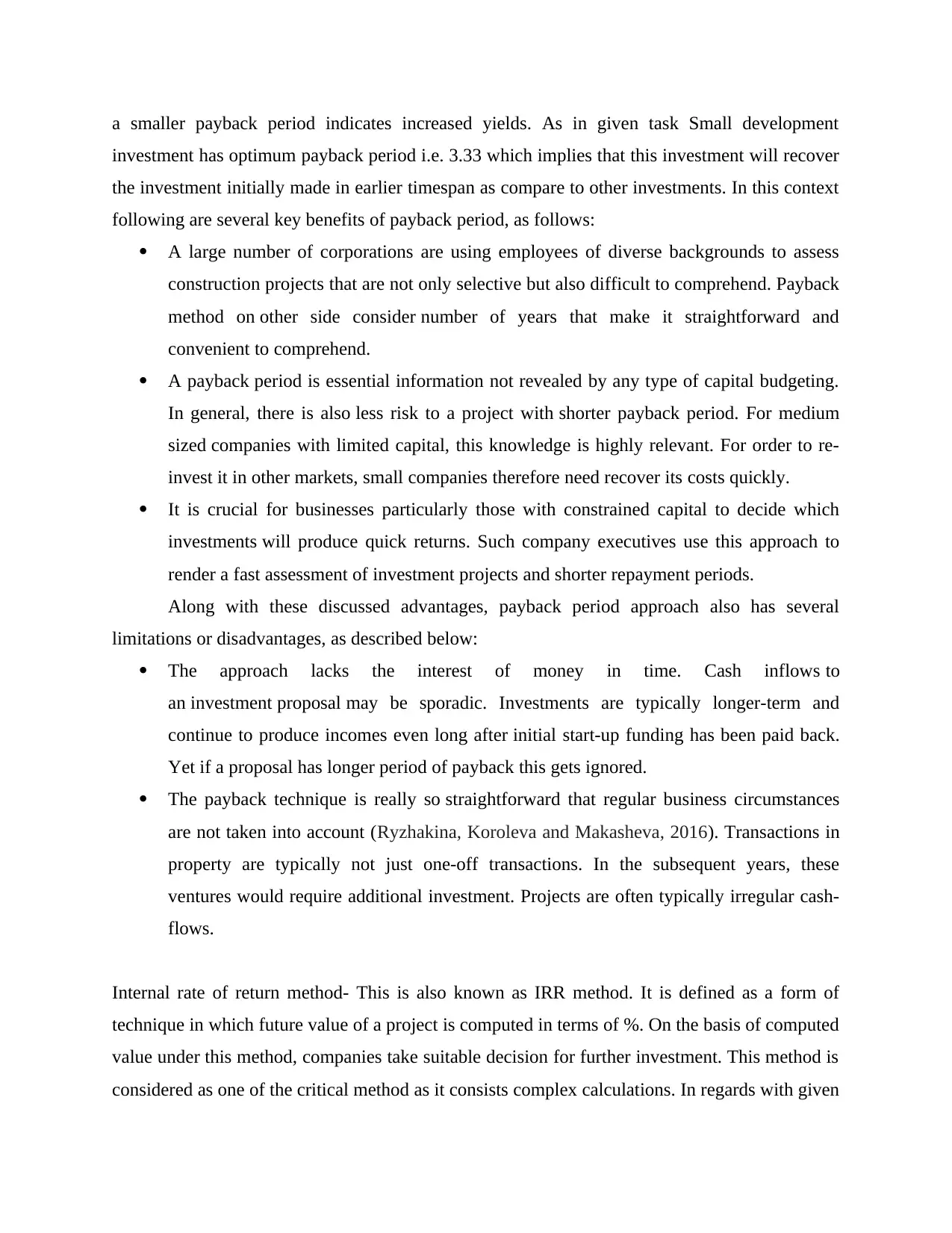
a smaller payback period indicates increased yields. As in given task Small development
investment has optimum payback period i.e. 3.33 which implies that this investment will recover
the investment initially made in earlier timespan as compare to other investments. In this context
following are several key benefits of payback period, as follows:
A large number of corporations are using employees of diverse backgrounds to assess
construction projects that are not only selective but also difficult to comprehend. Payback
method on other side consider number of years that make it straightforward and
convenient to comprehend.
A payback period is essential information not revealed by any type of capital budgeting.
In general, there is also less risk to a project with shorter payback period. For medium
sized companies with limited capital, this knowledge is highly relevant. For order to re-
invest it in other markets, small companies therefore need recover its costs quickly.
It is crucial for businesses particularly those with constrained capital to decide which
investments will produce quick returns. Such company executives use this approach to
render a fast assessment of investment projects and shorter repayment periods.
Along with these discussed advantages, payback period approach also has several
limitations or disadvantages, as described below:
The approach lacks the interest of money in time. Cash inflows to
an investment proposal may be sporadic. Investments are typically longer-term and
continue to produce incomes even long after initial start-up funding has been paid back.
Yet if a proposal has longer period of payback this gets ignored.
The payback technique is really so straightforward that regular business circumstances
are not taken into account (Ryzhakina, Koroleva and Makasheva, 2016). Transactions in
property are typically not just one-off transactions. In the subsequent years, these
ventures would require additional investment. Projects are often typically irregular cash-
flows.
Internal rate of return method- This is also known as IRR method. It is defined as a form of
technique in which future value of a project is computed in terms of %. On the basis of computed
value under this method, companies take suitable decision for further investment. This method is
considered as one of the critical method as it consists complex calculations. In regards with given
investment has optimum payback period i.e. 3.33 which implies that this investment will recover
the investment initially made in earlier timespan as compare to other investments. In this context
following are several key benefits of payback period, as follows:
A large number of corporations are using employees of diverse backgrounds to assess
construction projects that are not only selective but also difficult to comprehend. Payback
method on other side consider number of years that make it straightforward and
convenient to comprehend.
A payback period is essential information not revealed by any type of capital budgeting.
In general, there is also less risk to a project with shorter payback period. For medium
sized companies with limited capital, this knowledge is highly relevant. For order to re-
invest it in other markets, small companies therefore need recover its costs quickly.
It is crucial for businesses particularly those with constrained capital to decide which
investments will produce quick returns. Such company executives use this approach to
render a fast assessment of investment projects and shorter repayment periods.
Along with these discussed advantages, payback period approach also has several
limitations or disadvantages, as described below:
The approach lacks the interest of money in time. Cash inflows to
an investment proposal may be sporadic. Investments are typically longer-term and
continue to produce incomes even long after initial start-up funding has been paid back.
Yet if a proposal has longer period of payback this gets ignored.
The payback technique is really so straightforward that regular business circumstances
are not taken into account (Ryzhakina, Koroleva and Makasheva, 2016). Transactions in
property are typically not just one-off transactions. In the subsequent years, these
ventures would require additional investment. Projects are often typically irregular cash-
flows.
Internal rate of return method- This is also known as IRR method. It is defined as a form of
technique in which future value of a project is computed in terms of %. On the basis of computed
value under this method, companies take suitable decision for further investment. This method is
considered as one of the critical method as it consists complex calculations. In regards with given
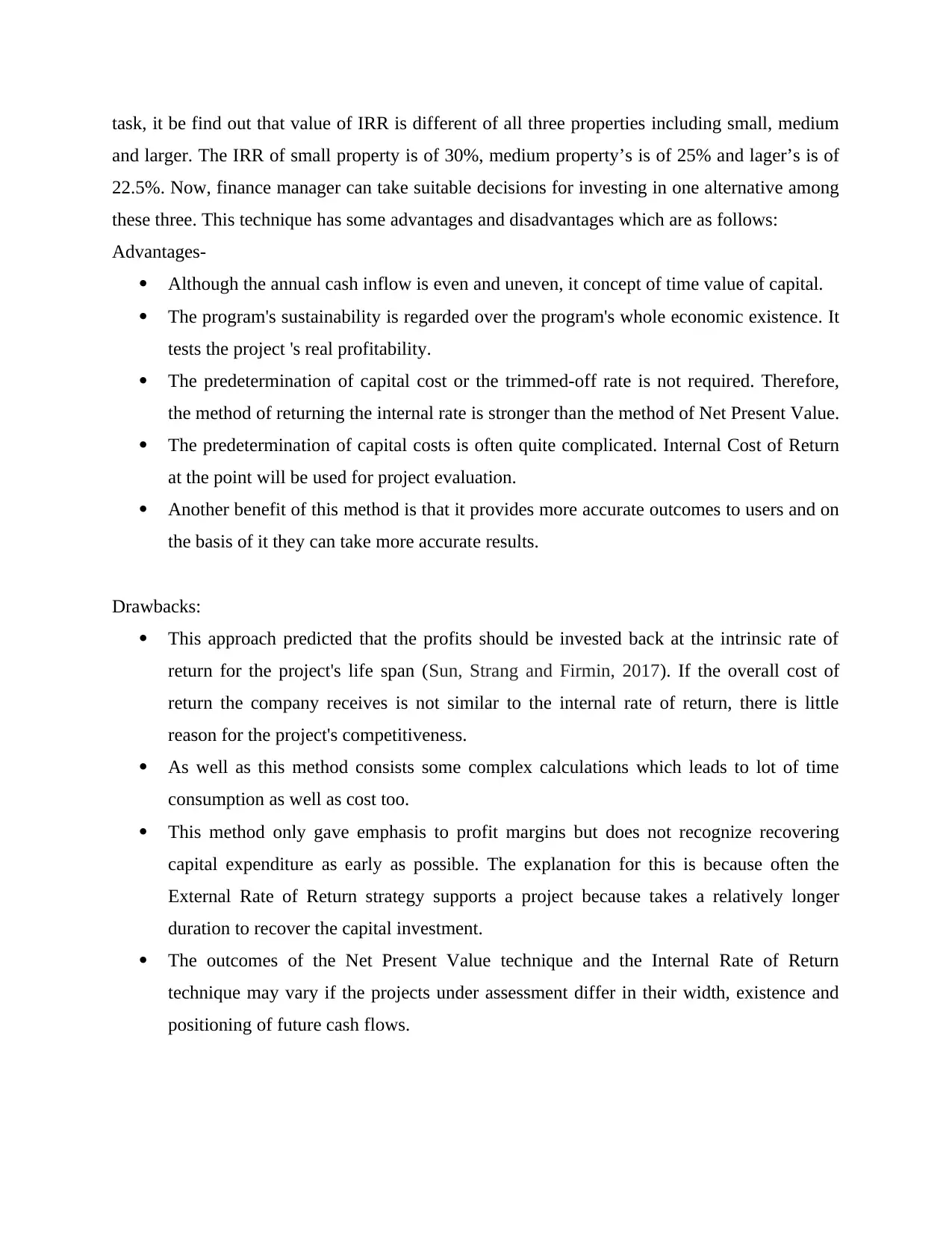
task, it be find out that value of IRR is different of all three properties including small, medium
and larger. The IRR of small property is of 30%, medium property’s is of 25% and lager’s is of
22.5%. Now, finance manager can take suitable decisions for investing in one alternative among
these three. This technique has some advantages and disadvantages which are as follows:
Advantages-
Although the annual cash inflow is even and uneven, it concept of time value of capital.
The program's sustainability is regarded over the program's whole economic existence. It
tests the project 's real profitability.
The predetermination of capital cost or the trimmed-off rate is not required. Therefore,
the method of returning the internal rate is stronger than the method of Net Present Value.
The predetermination of capital costs is often quite complicated. Internal Cost of Return
at the point will be used for project evaluation.
Another benefit of this method is that it provides more accurate outcomes to users and on
the basis of it they can take more accurate results.
Drawbacks:
This approach predicted that the profits should be invested back at the intrinsic rate of
return for the project's life span (Sun, Strang and Firmin, 2017). If the overall cost of
return the company receives is not similar to the internal rate of return, there is little
reason for the project's competitiveness.
As well as this method consists some complex calculations which leads to lot of time
consumption as well as cost too.
This method only gave emphasis to profit margins but does not recognize recovering
capital expenditure as early as possible. The explanation for this is because often the
External Rate of Return strategy supports a project because takes a relatively longer
duration to recover the capital investment.
The outcomes of the Net Present Value technique and the Internal Rate of Return
technique may vary if the projects under assessment differ in their width, existence and
positioning of future cash flows.
and larger. The IRR of small property is of 30%, medium property’s is of 25% and lager’s is of
22.5%. Now, finance manager can take suitable decisions for investing in one alternative among
these three. This technique has some advantages and disadvantages which are as follows:
Advantages-
Although the annual cash inflow is even and uneven, it concept of time value of capital.
The program's sustainability is regarded over the program's whole economic existence. It
tests the project 's real profitability.
The predetermination of capital cost or the trimmed-off rate is not required. Therefore,
the method of returning the internal rate is stronger than the method of Net Present Value.
The predetermination of capital costs is often quite complicated. Internal Cost of Return
at the point will be used for project evaluation.
Another benefit of this method is that it provides more accurate outcomes to users and on
the basis of it they can take more accurate results.
Drawbacks:
This approach predicted that the profits should be invested back at the intrinsic rate of
return for the project's life span (Sun, Strang and Firmin, 2017). If the overall cost of
return the company receives is not similar to the internal rate of return, there is little
reason for the project's competitiveness.
As well as this method consists some complex calculations which leads to lot of time
consumption as well as cost too.
This method only gave emphasis to profit margins but does not recognize recovering
capital expenditure as early as possible. The explanation for this is because often the
External Rate of Return strategy supports a project because takes a relatively longer
duration to recover the capital investment.
The outcomes of the Net Present Value technique and the Internal Rate of Return
technique may vary if the projects under assessment differ in their width, existence and
positioning of future cash flows.
⊘ This is a preview!⊘
Do you want full access?
Subscribe today to unlock all pages.

Trusted by 1+ million students worldwide
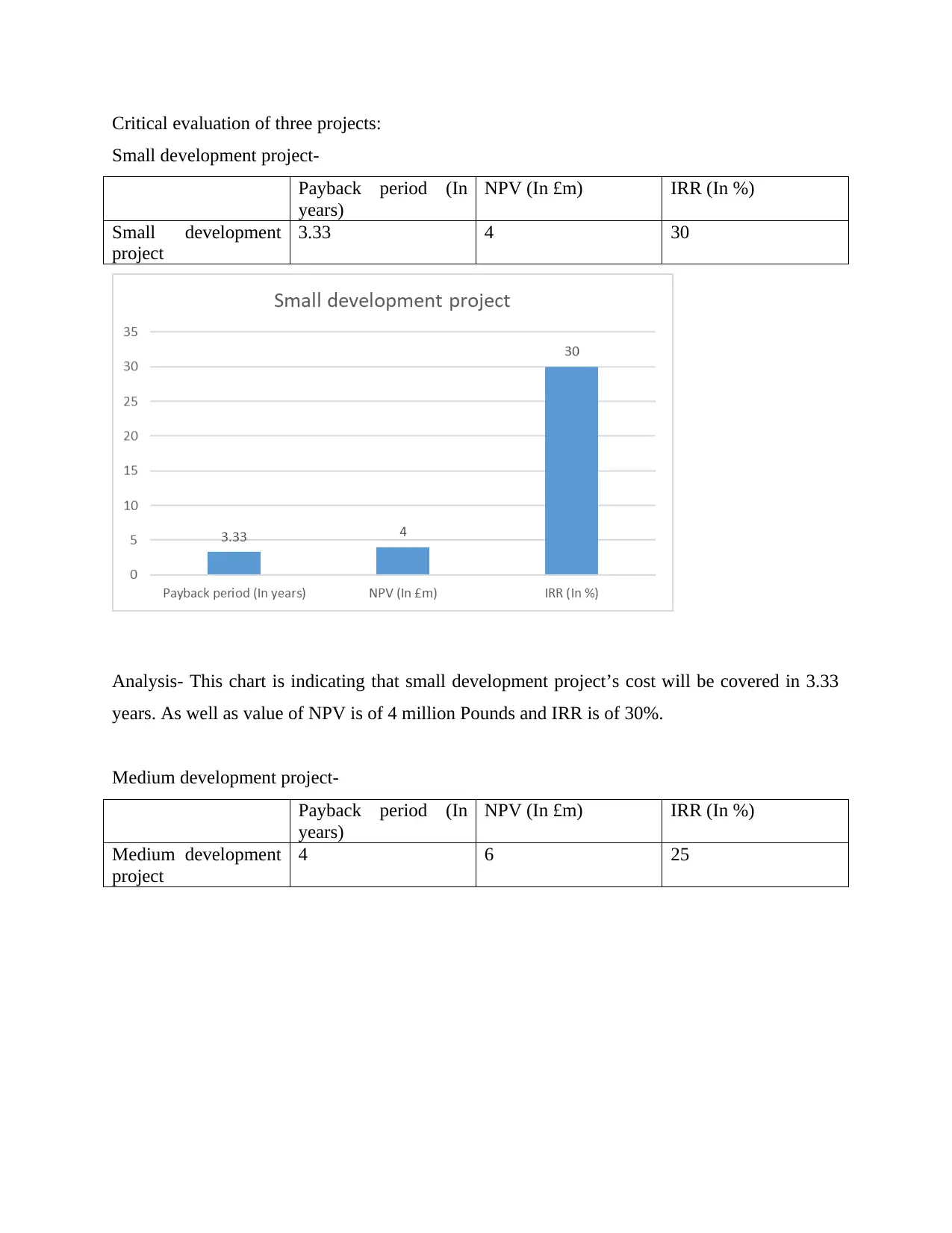
Critical evaluation of three projects:
Small development project-
Payback period (In
years)
NPV (In £m) IRR (In %)
Small development
project
3.33 4 30
Analysis- This chart is indicating that small development project’s cost will be covered in 3.33
years. As well as value of NPV is of 4 million Pounds and IRR is of 30%.
Medium development project-
Payback period (In
years)
NPV (In £m) IRR (In %)
Medium development
project
4 6 25
Small development project-
Payback period (In
years)
NPV (In £m) IRR (In %)
Small development
project
3.33 4 30
Analysis- This chart is indicating that small development project’s cost will be covered in 3.33
years. As well as value of NPV is of 4 million Pounds and IRR is of 30%.
Medium development project-
Payback period (In
years)
NPV (In £m) IRR (In %)
Medium development
project
4 6 25
Paraphrase This Document
Need a fresh take? Get an instant paraphrase of this document with our AI Paraphraser
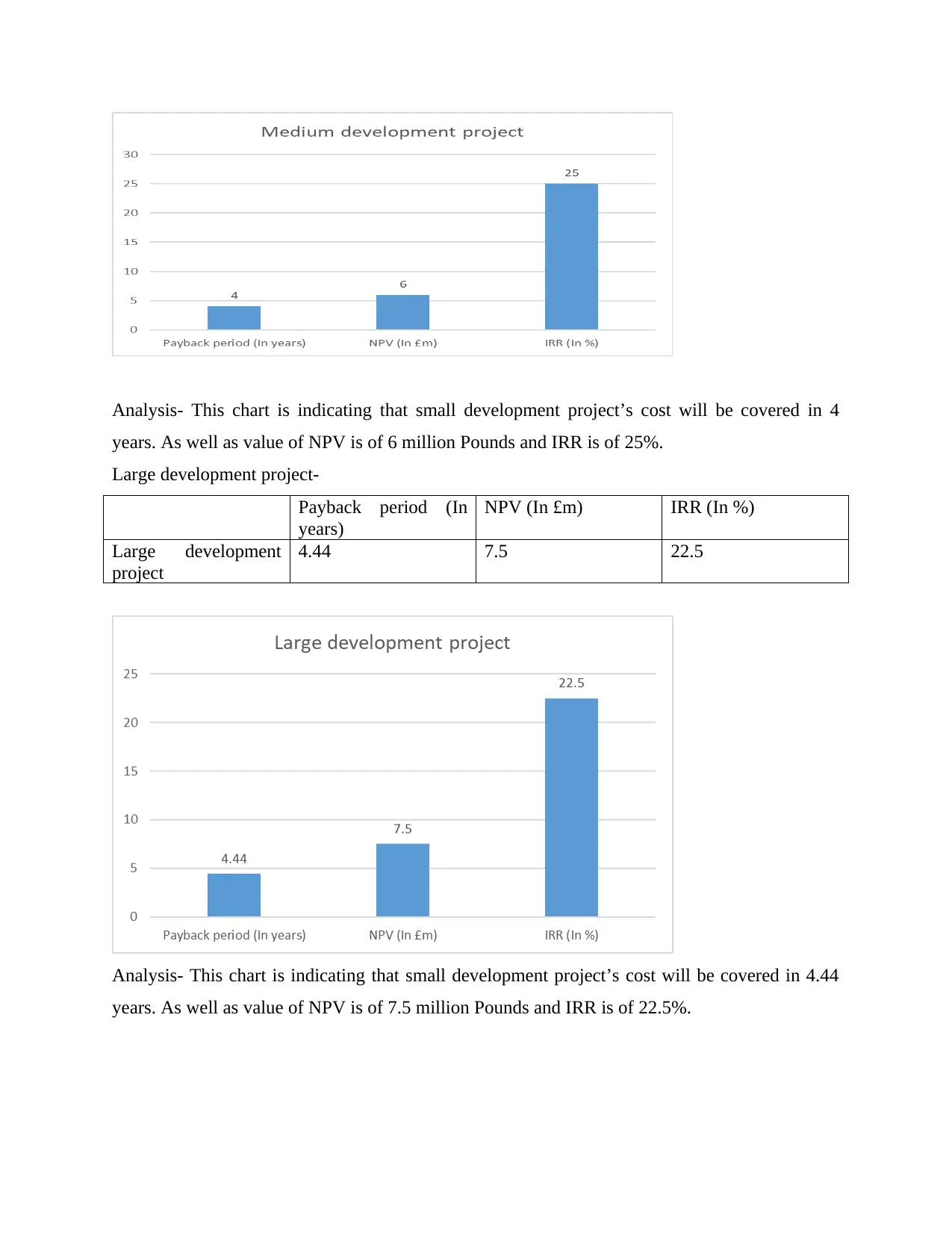
Analysis- This chart is indicating that small development project’s cost will be covered in 4
years. As well as value of NPV is of 6 million Pounds and IRR is of 25%.
Large development project-
Payback period (In
years)
NPV (In £m) IRR (In %)
Large development
project
4.44 7.5 22.5
Analysis- This chart is indicating that small development project’s cost will be covered in 4.44
years. As well as value of NPV is of 7.5 million Pounds and IRR is of 22.5%.
years. As well as value of NPV is of 6 million Pounds and IRR is of 25%.
Large development project-
Payback period (In
years)
NPV (In £m) IRR (In %)
Large development
project
4.44 7.5 22.5
Analysis- This chart is indicating that small development project’s cost will be covered in 4.44
years. As well as value of NPV is of 7.5 million Pounds and IRR is of 22.5%.
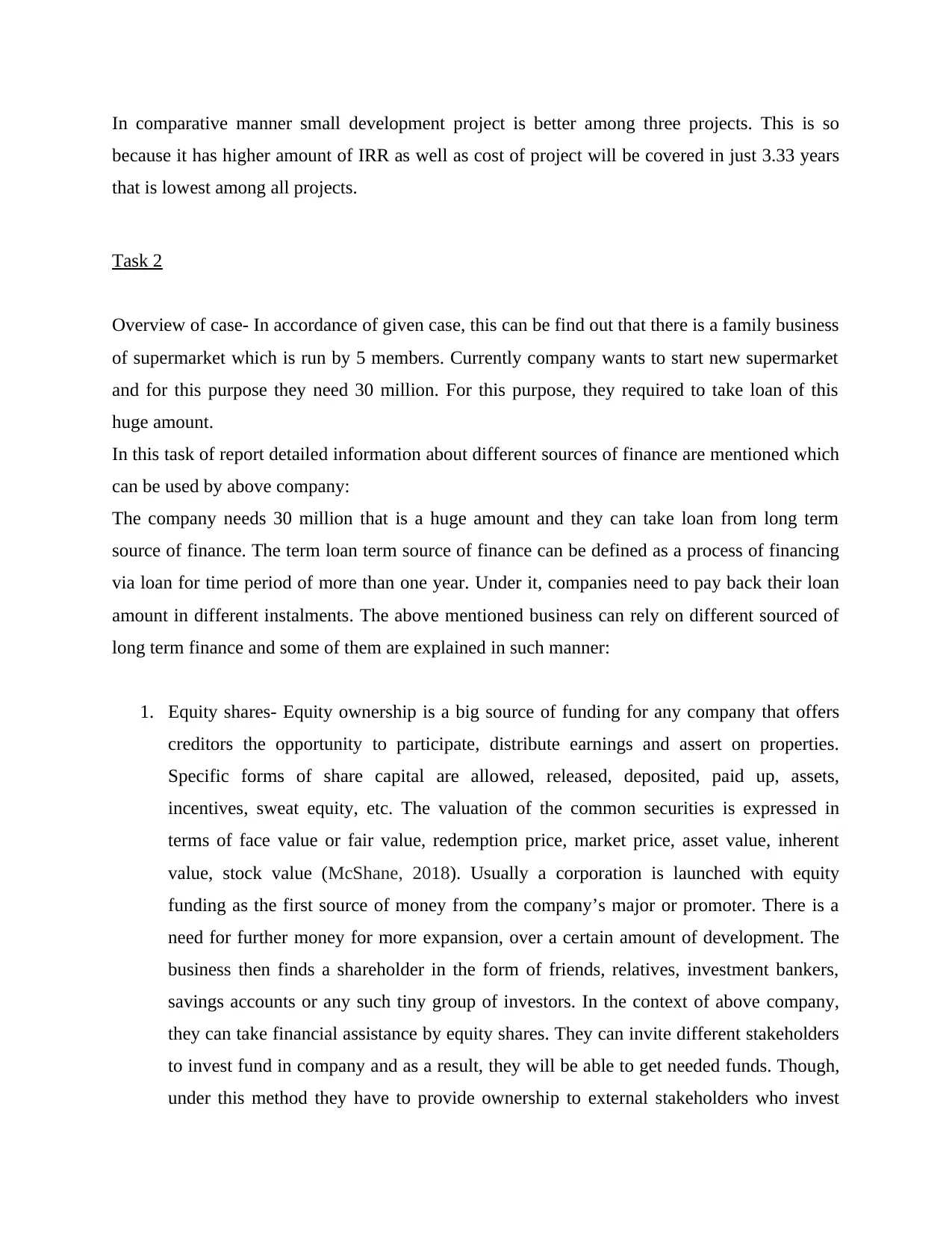
In comparative manner small development project is better among three projects. This is so
because it has higher amount of IRR as well as cost of project will be covered in just 3.33 years
that is lowest among all projects.
Task 2
Overview of case- In accordance of given case, this can be find out that there is a family business
of supermarket which is run by 5 members. Currently company wants to start new supermarket
and for this purpose they need 30 million. For this purpose, they required to take loan of this
huge amount.
In this task of report detailed information about different sources of finance are mentioned which
can be used by above company:
The company needs 30 million that is a huge amount and they can take loan from long term
source of finance. The term loan term source of finance can be defined as a process of financing
via loan for time period of more than one year. Under it, companies need to pay back their loan
amount in different instalments. The above mentioned business can rely on different sourced of
long term finance and some of them are explained in such manner:
1. Equity shares- Equity ownership is a big source of funding for any company that offers
creditors the opportunity to participate, distribute earnings and assert on properties.
Specific forms of share capital are allowed, released, deposited, paid up, assets,
incentives, sweat equity, etc. The valuation of the common securities is expressed in
terms of face value or fair value, redemption price, market price, asset value, inherent
value, stock value (McShane, 2018). Usually a corporation is launched with equity
funding as the first source of money from the company’s major or promoter. There is a
need for further money for more expansion, over a certain amount of development. The
business then finds a shareholder in the form of friends, relatives, investment bankers,
savings accounts or any such tiny group of investors. In the context of above company,
they can take financial assistance by equity shares. They can invite different stakeholders
to invest fund in company and as a result, they will be able to get needed funds. Though,
under this method they have to provide ownership to external stakeholders who invest
because it has higher amount of IRR as well as cost of project will be covered in just 3.33 years
that is lowest among all projects.
Task 2
Overview of case- In accordance of given case, this can be find out that there is a family business
of supermarket which is run by 5 members. Currently company wants to start new supermarket
and for this purpose they need 30 million. For this purpose, they required to take loan of this
huge amount.
In this task of report detailed information about different sources of finance are mentioned which
can be used by above company:
The company needs 30 million that is a huge amount and they can take loan from long term
source of finance. The term loan term source of finance can be defined as a process of financing
via loan for time period of more than one year. Under it, companies need to pay back their loan
amount in different instalments. The above mentioned business can rely on different sourced of
long term finance and some of them are explained in such manner:
1. Equity shares- Equity ownership is a big source of funding for any company that offers
creditors the opportunity to participate, distribute earnings and assert on properties.
Specific forms of share capital are allowed, released, deposited, paid up, assets,
incentives, sweat equity, etc. The valuation of the common securities is expressed in
terms of face value or fair value, redemption price, market price, asset value, inherent
value, stock value (McShane, 2018). Usually a corporation is launched with equity
funding as the first source of money from the company’s major or promoter. There is a
need for further money for more expansion, over a certain amount of development. The
business then finds a shareholder in the form of friends, relatives, investment bankers,
savings accounts or any such tiny group of investors. In the context of above company,
they can take financial assistance by equity shares. They can invite different stakeholders
to invest fund in company and as a result, they will be able to get needed funds. Though,
under this method they have to provide ownership to external stakeholders who invest
⊘ This is a preview!⊘
Do you want full access?
Subscribe today to unlock all pages.

Trusted by 1+ million students worldwide
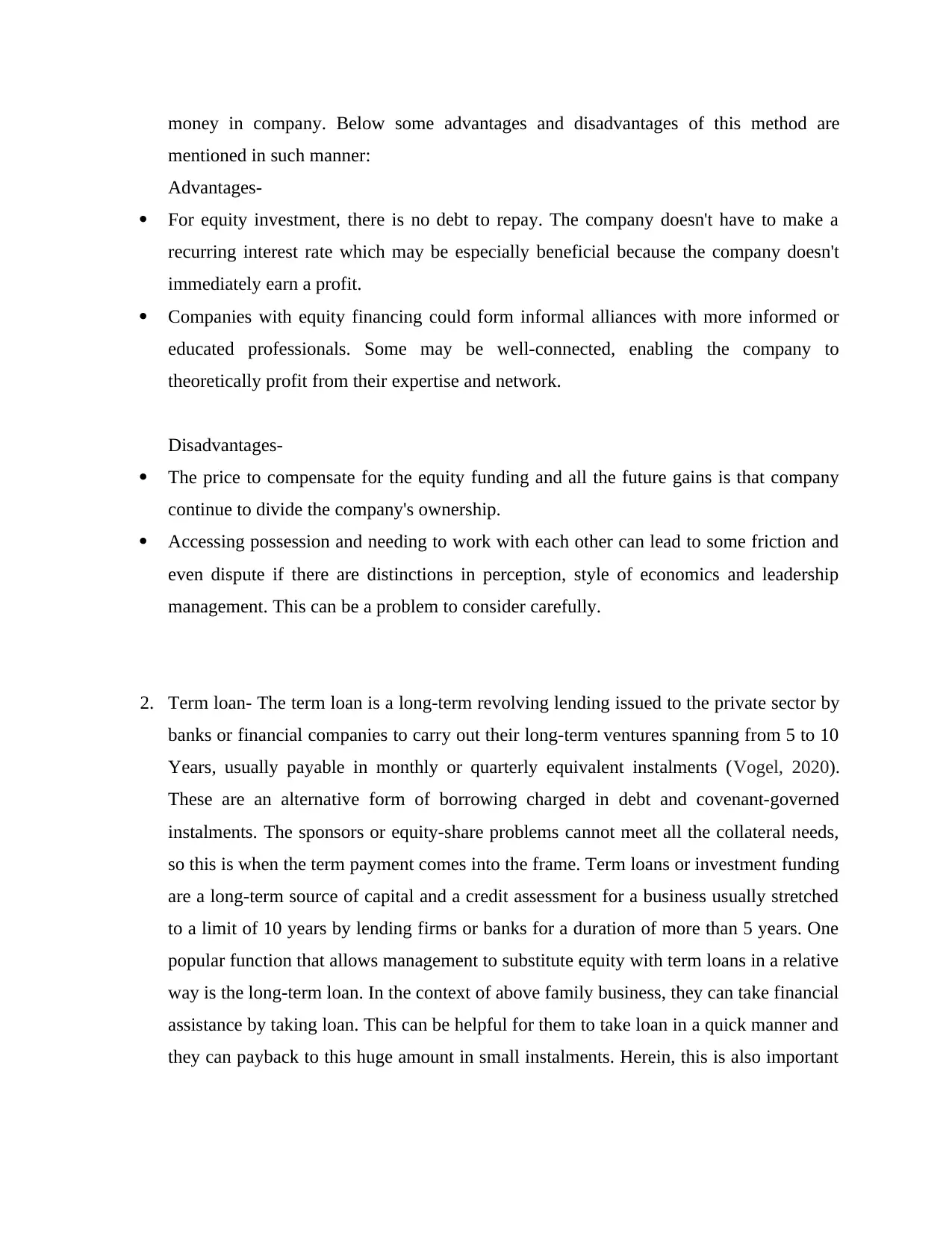
money in company. Below some advantages and disadvantages of this method are
mentioned in such manner:
Advantages-
For equity investment, there is no debt to repay. The company doesn't have to make a
recurring interest rate which may be especially beneficial because the company doesn't
immediately earn a profit.
Companies with equity financing could form informal alliances with more informed or
educated professionals. Some may be well-connected, enabling the company to
theoretically profit from their expertise and network.
Disadvantages-
The price to compensate for the equity funding and all the future gains is that company
continue to divide the company's ownership.
Accessing possession and needing to work with each other can lead to some friction and
even dispute if there are distinctions in perception, style of economics and leadership
management. This can be a problem to consider carefully.
2. Term loan- The term loan is a long-term revolving lending issued to the private sector by
banks or financial companies to carry out their long-term ventures spanning from 5 to 10
Years, usually payable in monthly or quarterly equivalent instalments (Vogel, 2020).
These are an alternative form of borrowing charged in debt and covenant-governed
instalments. The sponsors or equity-share problems cannot meet all the collateral needs,
so this is when the term payment comes into the frame. Term loans or investment funding
are a long-term source of capital and a credit assessment for a business usually stretched
to a limit of 10 years by lending firms or banks for a duration of more than 5 years. One
popular function that allows management to substitute equity with term loans in a relative
way is the long-term loan. In the context of above family business, they can take financial
assistance by taking loan. This can be helpful for them to take loan in a quick manner and
they can payback to this huge amount in small instalments. Herein, this is also important
mentioned in such manner:
Advantages-
For equity investment, there is no debt to repay. The company doesn't have to make a
recurring interest rate which may be especially beneficial because the company doesn't
immediately earn a profit.
Companies with equity financing could form informal alliances with more informed or
educated professionals. Some may be well-connected, enabling the company to
theoretically profit from their expertise and network.
Disadvantages-
The price to compensate for the equity funding and all the future gains is that company
continue to divide the company's ownership.
Accessing possession and needing to work with each other can lead to some friction and
even dispute if there are distinctions in perception, style of economics and leadership
management. This can be a problem to consider carefully.
2. Term loan- The term loan is a long-term revolving lending issued to the private sector by
banks or financial companies to carry out their long-term ventures spanning from 5 to 10
Years, usually payable in monthly or quarterly equivalent instalments (Vogel, 2020).
These are an alternative form of borrowing charged in debt and covenant-governed
instalments. The sponsors or equity-share problems cannot meet all the collateral needs,
so this is when the term payment comes into the frame. Term loans or investment funding
are a long-term source of capital and a credit assessment for a business usually stretched
to a limit of 10 years by lending firms or banks for a duration of more than 5 years. One
popular function that allows management to substitute equity with term loans in a relative
way is the long-term loan. In the context of above family business, they can take financial
assistance by taking loan. This can be helpful for them to take loan in a quick manner and
they can payback to this huge amount in small instalments. Herein, this is also important
Paraphrase This Document
Need a fresh take? Get an instant paraphrase of this document with our AI Paraphraser
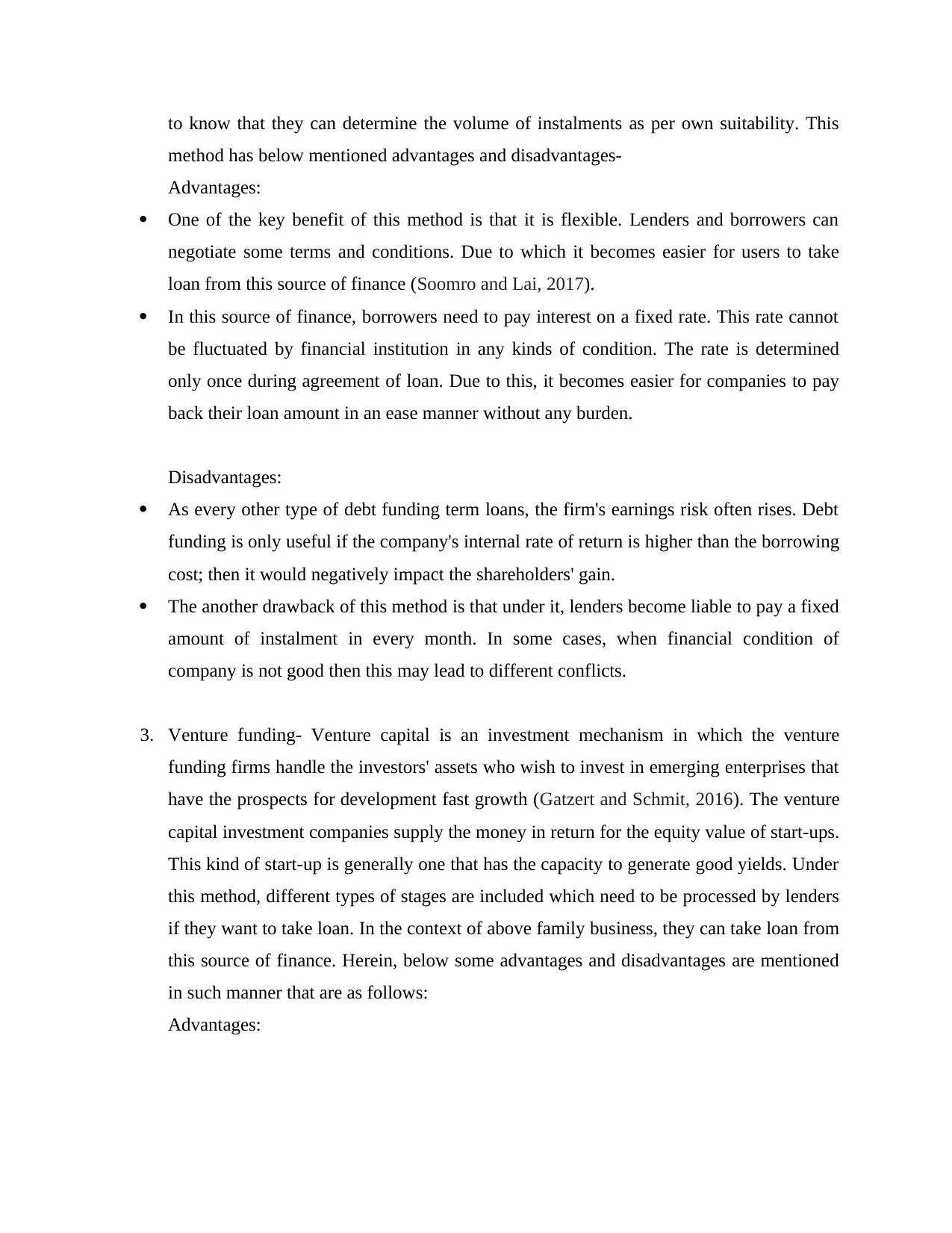
to know that they can determine the volume of instalments as per own suitability. This
method has below mentioned advantages and disadvantages-
Advantages:
One of the key benefit of this method is that it is flexible. Lenders and borrowers can
negotiate some terms and conditions. Due to which it becomes easier for users to take
loan from this source of finance (Soomro and Lai, 2017).
In this source of finance, borrowers need to pay interest on a fixed rate. This rate cannot
be fluctuated by financial institution in any kinds of condition. The rate is determined
only once during agreement of loan. Due to this, it becomes easier for companies to pay
back their loan amount in an ease manner without any burden.
Disadvantages:
As every other type of debt funding term loans, the firm's earnings risk often rises. Debt
funding is only useful if the company's internal rate of return is higher than the borrowing
cost; then it would negatively impact the shareholders' gain.
The another drawback of this method is that under it, lenders become liable to pay a fixed
amount of instalment in every month. In some cases, when financial condition of
company is not good then this may lead to different conflicts.
3. Venture funding- Venture capital is an investment mechanism in which the venture
funding firms handle the investors' assets who wish to invest in emerging enterprises that
have the prospects for development fast growth (Gatzert and Schmit, 2016). The venture
capital investment companies supply the money in return for the equity value of start-ups.
This kind of start-up is generally one that has the capacity to generate good yields. Under
this method, different types of stages are included which need to be processed by lenders
if they want to take loan. In the context of above family business, they can take loan from
this source of finance. Herein, below some advantages and disadvantages are mentioned
in such manner that are as follows:
Advantages:
method has below mentioned advantages and disadvantages-
Advantages:
One of the key benefit of this method is that it is flexible. Lenders and borrowers can
negotiate some terms and conditions. Due to which it becomes easier for users to take
loan from this source of finance (Soomro and Lai, 2017).
In this source of finance, borrowers need to pay interest on a fixed rate. This rate cannot
be fluctuated by financial institution in any kinds of condition. The rate is determined
only once during agreement of loan. Due to this, it becomes easier for companies to pay
back their loan amount in an ease manner without any burden.
Disadvantages:
As every other type of debt funding term loans, the firm's earnings risk often rises. Debt
funding is only useful if the company's internal rate of return is higher than the borrowing
cost; then it would negatively impact the shareholders' gain.
The another drawback of this method is that under it, lenders become liable to pay a fixed
amount of instalment in every month. In some cases, when financial condition of
company is not good then this may lead to different conflicts.
3. Venture funding- Venture capital is an investment mechanism in which the venture
funding firms handle the investors' assets who wish to invest in emerging enterprises that
have the prospects for development fast growth (Gatzert and Schmit, 2016). The venture
capital investment companies supply the money in return for the equity value of start-ups.
This kind of start-up is generally one that has the capacity to generate good yields. Under
this method, different types of stages are included which need to be processed by lenders
if they want to take loan. In the context of above family business, they can take loan from
this source of finance. Herein, below some advantages and disadvantages are mentioned
in such manner that are as follows:
Advantages:
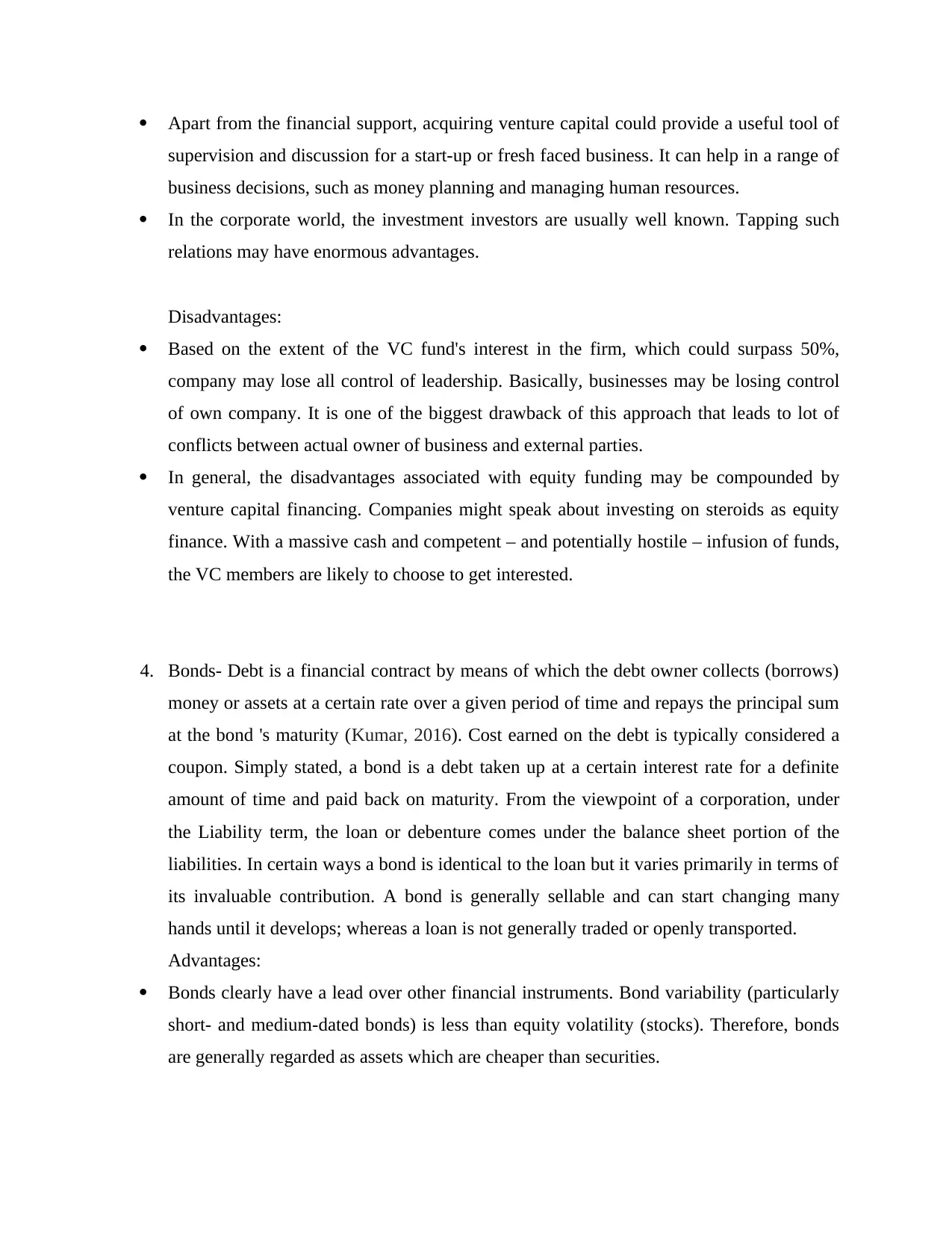
Apart from the financial support, acquiring venture capital could provide a useful tool of
supervision and discussion for a start-up or fresh faced business. It can help in a range of
business decisions, such as money planning and managing human resources.
In the corporate world, the investment investors are usually well known. Tapping such
relations may have enormous advantages.
Disadvantages:
Based on the extent of the VC fund's interest in the firm, which could surpass 50%,
company may lose all control of leadership. Basically, businesses may be losing control
of own company. It is one of the biggest drawback of this approach that leads to lot of
conflicts between actual owner of business and external parties.
In general, the disadvantages associated with equity funding may be compounded by
venture capital financing. Companies might speak about investing on steroids as equity
finance. With a massive cash and competent – and potentially hostile – infusion of funds,
the VC members are likely to choose to get interested.
4. Bonds- Debt is a financial contract by means of which the debt owner collects (borrows)
money or assets at a certain rate over a given period of time and repays the principal sum
at the bond 's maturity (Kumar, 2016). Cost earned on the debt is typically considered a
coupon. Simply stated, a bond is a debt taken up at a certain interest rate for a definite
amount of time and paid back on maturity. From the viewpoint of a corporation, under
the Liability term, the loan or debenture comes under the balance sheet portion of the
liabilities. In certain ways a bond is identical to the loan but it varies primarily in terms of
its invaluable contribution. A bond is generally sellable and can start changing many
hands until it develops; whereas a loan is not generally traded or openly transported.
Advantages:
Bonds clearly have a lead over other financial instruments. Bond variability (particularly
short- and medium-dated bonds) is less than equity volatility (stocks). Therefore, bonds
are generally regarded as assets which are cheaper than securities.
supervision and discussion for a start-up or fresh faced business. It can help in a range of
business decisions, such as money planning and managing human resources.
In the corporate world, the investment investors are usually well known. Tapping such
relations may have enormous advantages.
Disadvantages:
Based on the extent of the VC fund's interest in the firm, which could surpass 50%,
company may lose all control of leadership. Basically, businesses may be losing control
of own company. It is one of the biggest drawback of this approach that leads to lot of
conflicts between actual owner of business and external parties.
In general, the disadvantages associated with equity funding may be compounded by
venture capital financing. Companies might speak about investing on steroids as equity
finance. With a massive cash and competent – and potentially hostile – infusion of funds,
the VC members are likely to choose to get interested.
4. Bonds- Debt is a financial contract by means of which the debt owner collects (borrows)
money or assets at a certain rate over a given period of time and repays the principal sum
at the bond 's maturity (Kumar, 2016). Cost earned on the debt is typically considered a
coupon. Simply stated, a bond is a debt taken up at a certain interest rate for a definite
amount of time and paid back on maturity. From the viewpoint of a corporation, under
the Liability term, the loan or debenture comes under the balance sheet portion of the
liabilities. In certain ways a bond is identical to the loan but it varies primarily in terms of
its invaluable contribution. A bond is generally sellable and can start changing many
hands until it develops; whereas a loan is not generally traded or openly transported.
Advantages:
Bonds clearly have a lead over other financial instruments. Bond variability (particularly
short- and medium-dated bonds) is less than equity volatility (stocks). Therefore, bonds
are generally regarded as assets which are cheaper than securities.
⊘ This is a preview!⊘
Do you want full access?
Subscribe today to unlock all pages.

Trusted by 1+ million students worldwide
1 out of 15
Related Documents
Your All-in-One AI-Powered Toolkit for Academic Success.
+13062052269
info@desklib.com
Available 24*7 on WhatsApp / Email
![[object Object]](/_next/static/media/star-bottom.7253800d.svg)
Unlock your academic potential
Copyright © 2020–2025 A2Z Services. All Rights Reserved. Developed and managed by ZUCOL.



